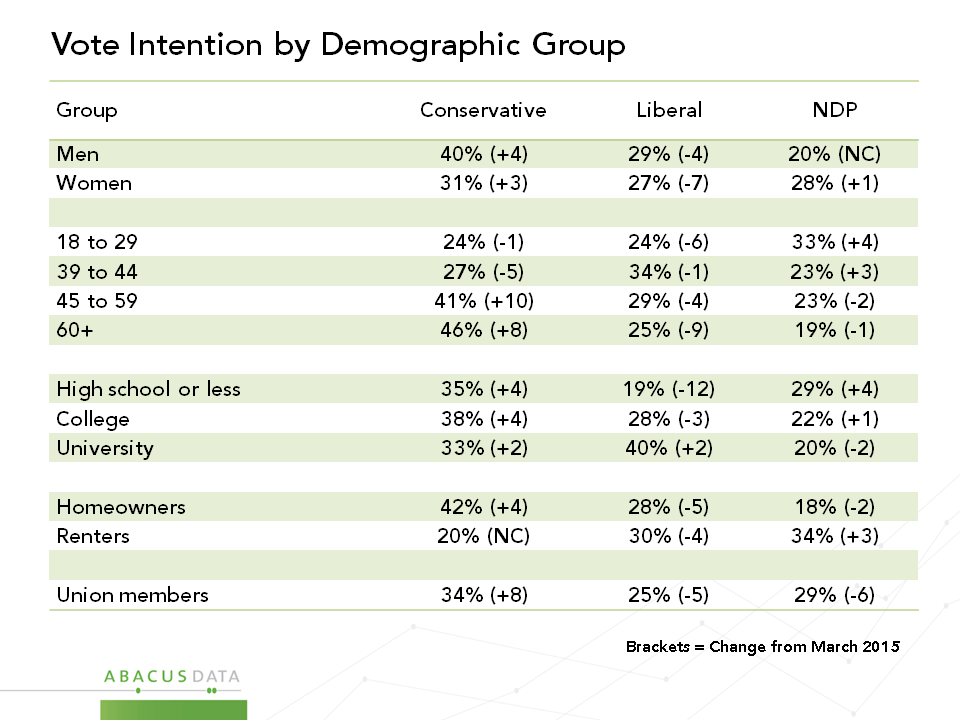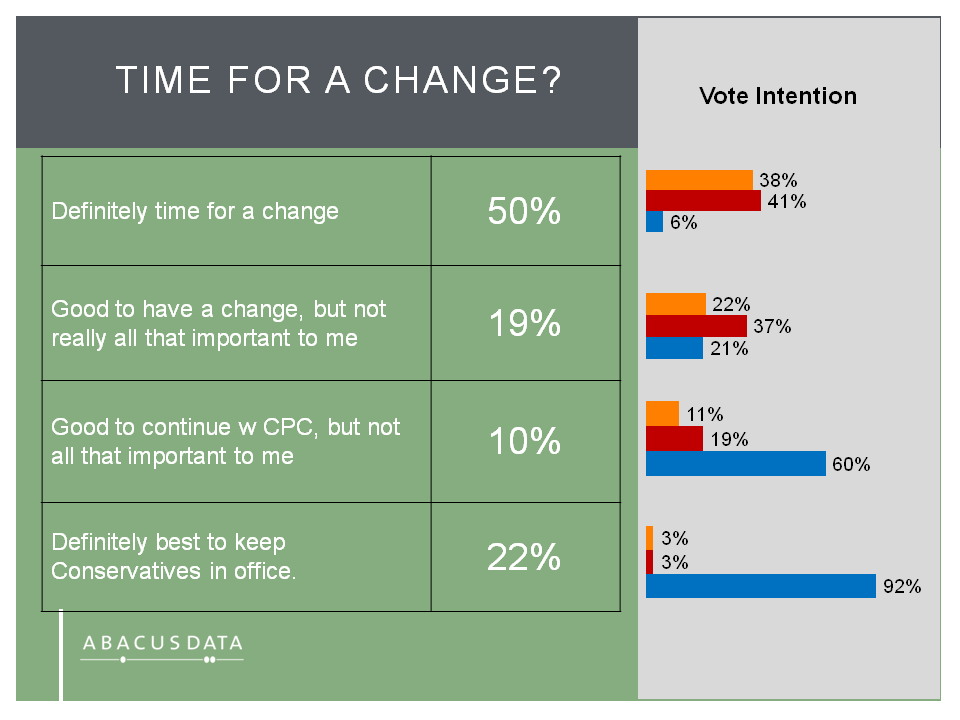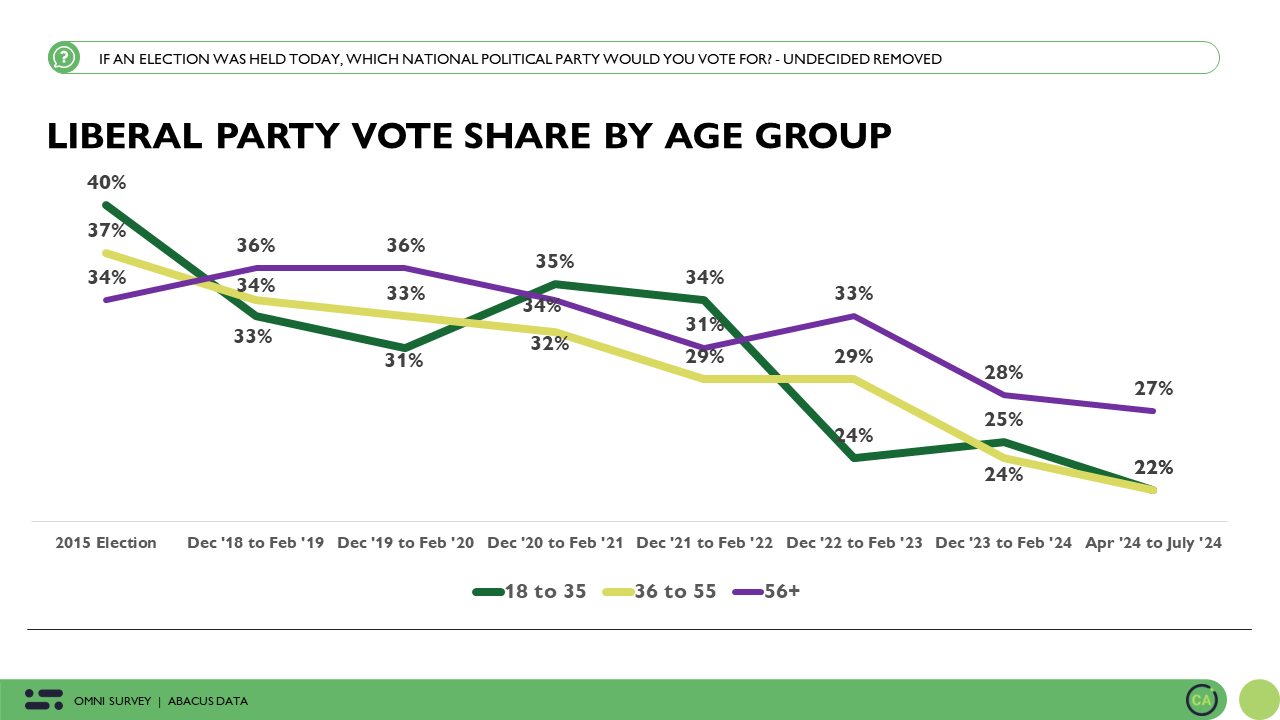Budget propels Conservatives to 8 point lead
April 30, 2015

Yesterday we released new polling data on how Canadians reacted to the Federal Budget and their perceptions about the economy. Today we explore voting inclinations.
VOTING INTENTION
The Conservative Party has opened up an 8-point lead over the Liberal Party. Across Canada, 36% of decided voters in our sample would vote Conservative, 28% Liberal and 24% NDP. The Green Party polls at 6% nationwide and 12% in BC. The BQ is at 20% in Quebec.
24% of respondents said they were undecided, up one point from last month.

Looking at the regional races where we have the largest sample sizes, in Ontario (sample = 364), the Conservatives lead the Liberals 41% to 30% with the NDP at 23%. In Quebec (sample = 263), the NDP are at 30%, Liberals 26%, the Conservatives 19% and the BQ 20%.
Much of the rise in CPC support is attributable to gains among those aged 45 and over. Conservative support is up 10 points among those 45 to 59 and 8-points among those 60 plus. Also worth noting is evidence that the Conservatives may have picked up support among union members, at the expense of both the NDP and the Liberals.
The slippage in Liberal support is more noticeable among women, those with the least formal education, and those under 30 or over 60.
The NDP has strengthened a bit among those under 45 and those with less formal education.

TIME FOR A CHANGE?
This month, we asked respondents to tell us how they feel about the idea of a change in government. One in two (50%) feel “it’s definitely time for a change in government”. Another 19% feel “it would be good to have a change, but it is not really that important to me.”
Just over one in five (22%) believe “it’s definitely best to keep the Conservatives in office” and another 10% feel “it would be good to continue with the same party in power, but it’s not all that important to me.”

These numbers highlight challenges and opportunities for each party. For the opposition parties, there aren’t enough people who are adamant about the need for change, to elect either the NDP or the Liberals, if they split their votes as they intend today. Currently, among those who are sure it’s time for a change, roughly equal proportions would vote Liberal (41%) and NDP (38%).
The Conservatives must hold the share they have of those voters who have a mild preference for continuity, and draw a bigger share among those who are inclined to prefer change, but don’t feel all that strongly about it. Currently, 21% of the latter group says they will probably vote Conservative.
Along with the rise in Conservative support, expectations of a Conservative win have grown as well. When asked which party would win the next federal election, 36% picked the Tories while 27% picked the Liberals. This is a 6-point increase for the Conservatives and a 7-point drop for the Liberals. Nine percent (9%) of Canadians think the NDP will win the next election.
Our data suggest that the federal budget (including the advertising which has surrounded it) has contributed to the improvement in standing for the Conservatives. Among voters who focus on jobs, taxes, debt, middle class incomes, and retirement security, the Conservatives have improved their competitiveness across the board.

THE UPSHOT?
The 2015 budget was a political milestone that the Conservatives have been looking forward to for several years, and they have used the improving fiscal situation to considerable advantage.
The budget measures, supported by extensive advertising about tax relief and spending on jobs and training programs has created a situation where the Conservative economic approach is very prominent, and for many people, appealing as well.
The results are an unmistakable sign to opposition parties that while many people are open to the idea of a change in government, not everyone feels strongly about that, or agree on what party should replace the Conservatives. To win, they must grow the inclination for change, and/or command the lion’s share of voters who prefer change.
The Conservatives, for their part, can only count on 22% to be rock solid in their defense: to win they need to continue to firm up support among those who are inclined towards them, but not passionately so, and to attract a bit more support among those who are inclined to want change, but don’t feel that strongly about it.
Methodology
Our survey was conducted online with 1,500 Canadians aged 18 and over from April 22 to April 24, 2015. A random sample of panelists was invited to complete the survey from a large representative panel of Canadians, recruited and managed by Research Now, one of the world’s leading provider of online research samples.
The Marketing Research and Intelligence Association policy limits statements about margins of sampling error for most online surveys. The margin of error for a comparable probability-based random sample of the same size is +/- 2.6%, 19 times out of 20. The data were weighted according to census data to ensure that the sample matched Canada’s population according to age, gender, educational attainment, and region. Totals may not add up to 100 due to rounding.

Abacus Data Inc.
We offer global research capacity with a strong focus on customer service, attention to detail and value added insight. Our team combines the experience of our Chairman Bruce Anderson, one of Canada’s leading research executives for two decades, with the energy, creativity and research expertise of CEO David Coletto, PhD.
In case you missed it, here are some of our recent releases:
Federal Budget a Success for Conservatives
Niqabs, Hijabs, Anxiety and Accommodation




